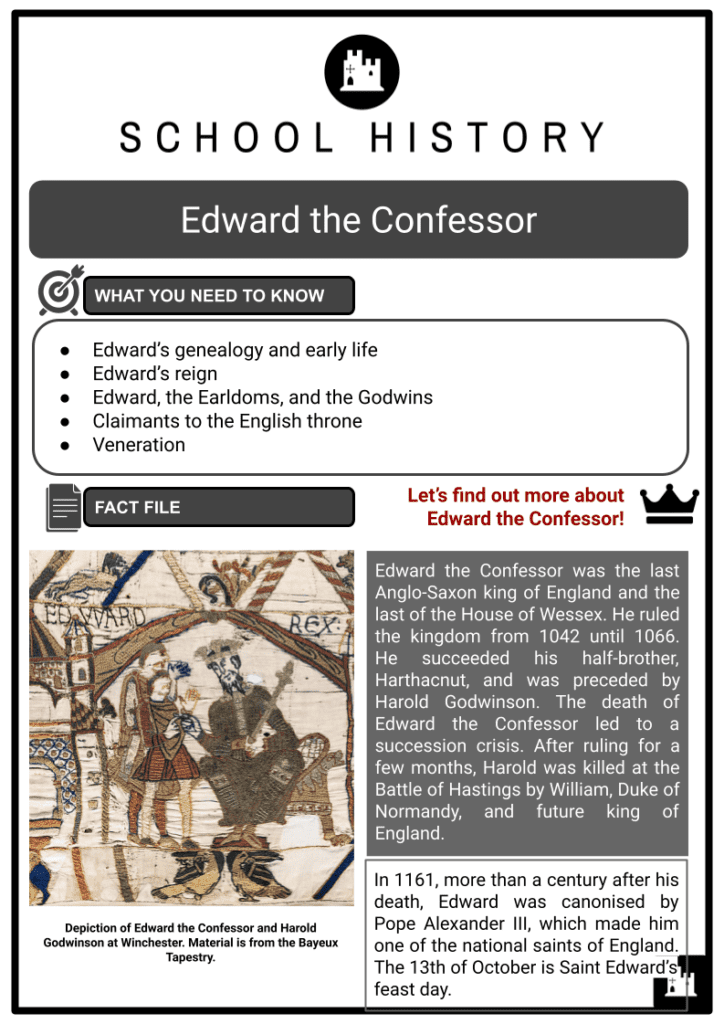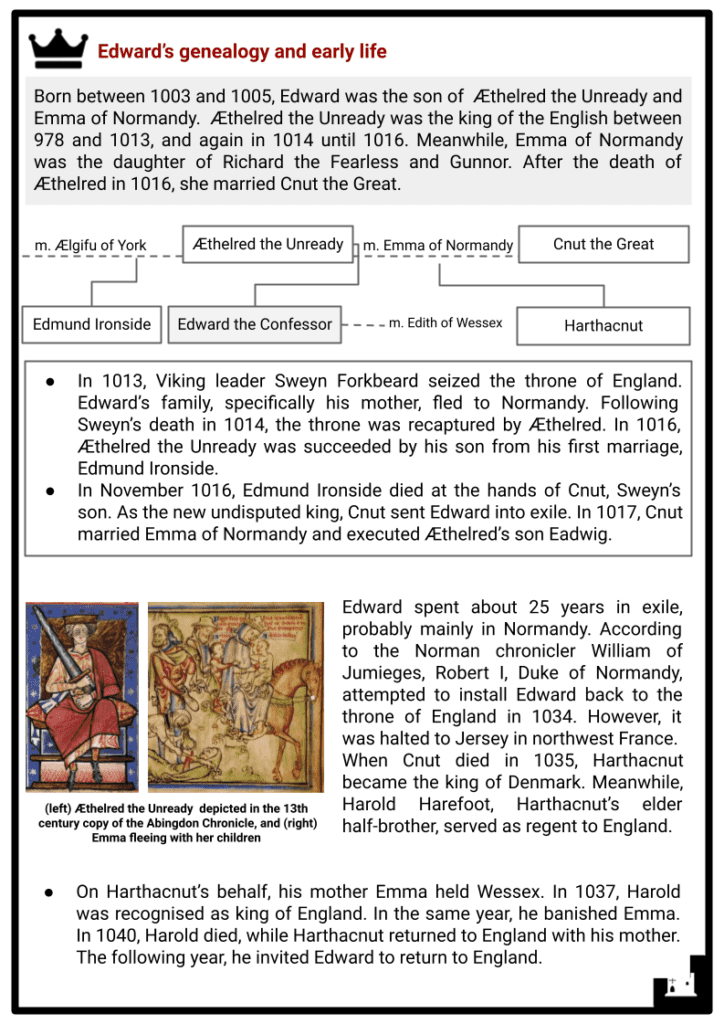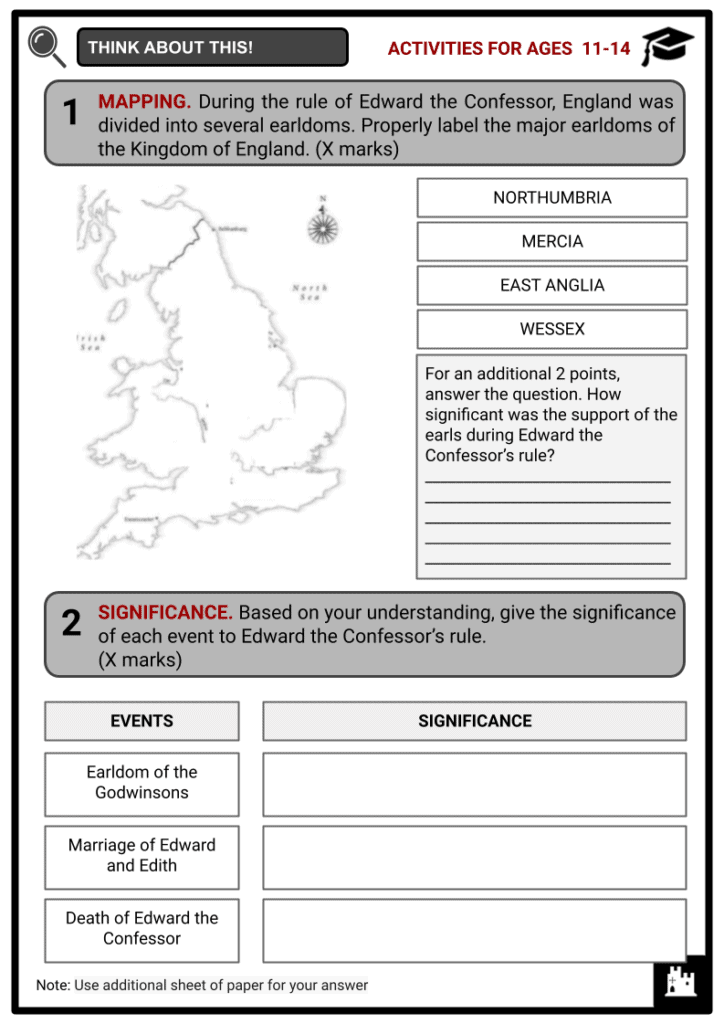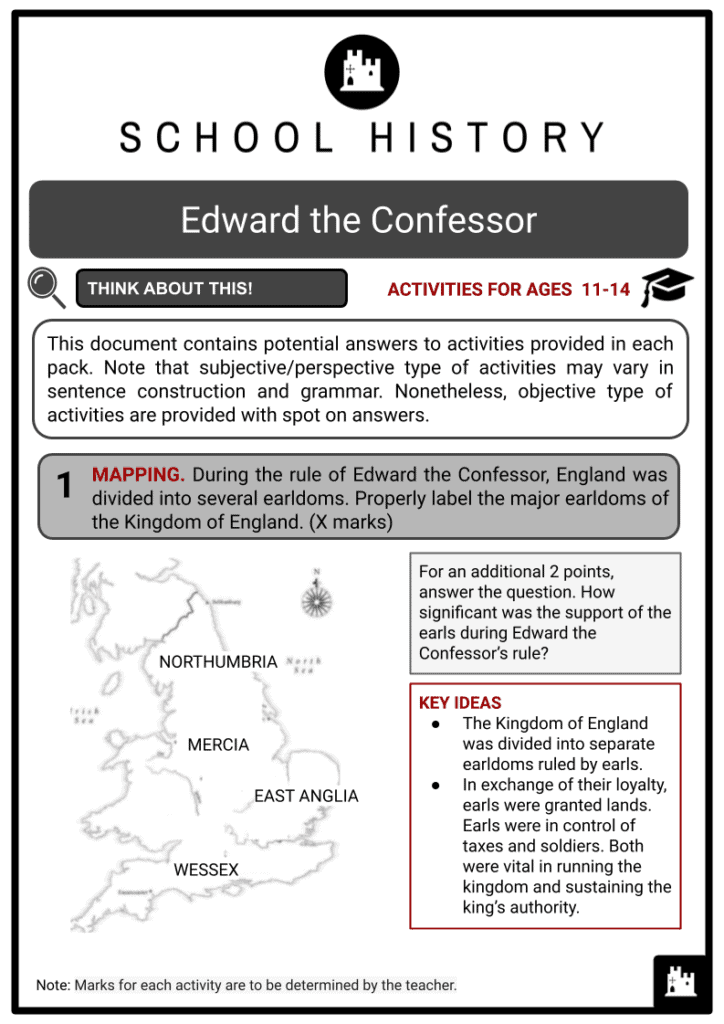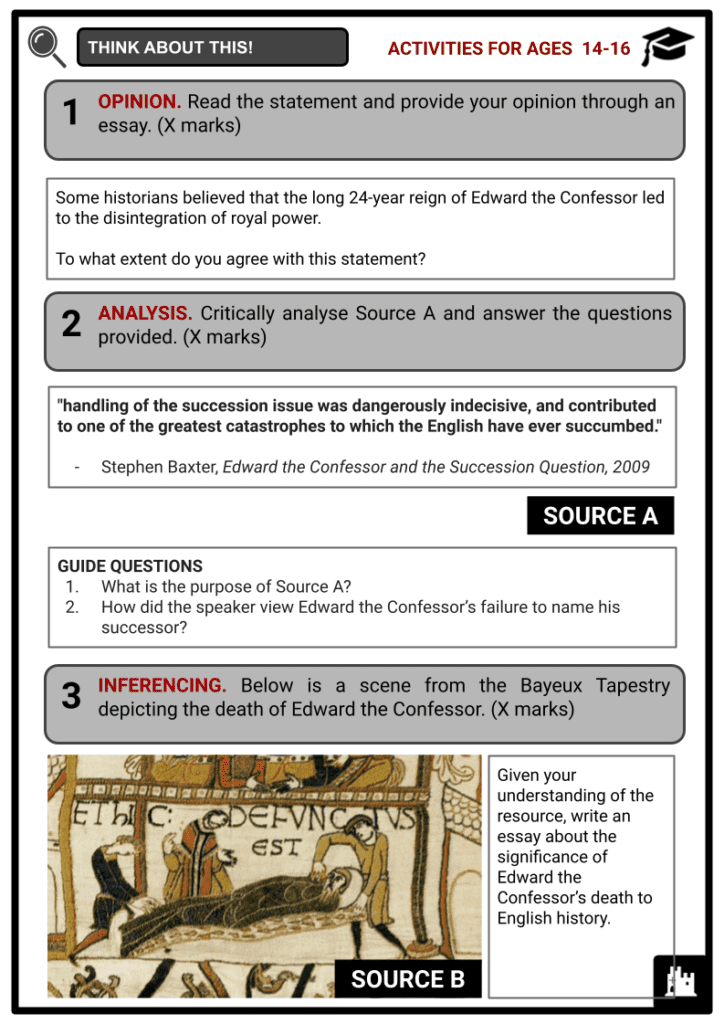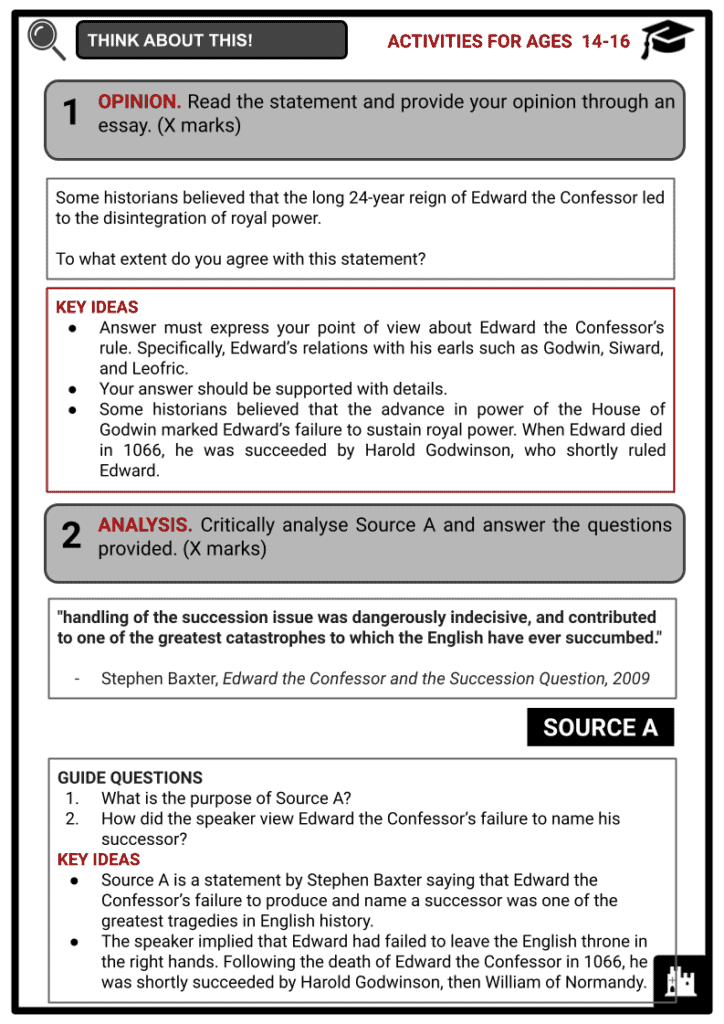Download Edward the Confessor Worksheets
Do you want to save dozens of hours in time? Get your evenings and weekends back? Be able to teach about Edward the Confessor to your students?
Our worksheet bundle includes a fact file and printable worksheets and student activities. Perfect for both the classroom and homeschooling!
Summary
- Edward’s genealogy and early life
- Edward’s reign
- Edward, the Earldoms, and the Godwins
- Claimants to the English throne
- Veneration
Key Facts And Information
Let’s find out more about Edward the Confessor!
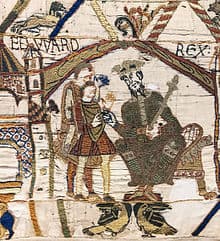
Edward the Confessor was the last Anglo-Saxon king of England and the last of the House of Wessex. He ruled the kingdom from 1042 until 1066. He succeeded his half-brother, Harthacnut, and was preceded by Harold Godwinson. The death of Edward the Confessor led to a succession crisis. After ruling for a few months, Harold was killed at the Battle of Hastings by William, Duke of Normandy, and future king of England.
- In 1161, more than a century after his death, Edward was canonised by Pope Alexander III, which made him one of the national saints of England. The 13th of October is Saint Edward’s feast day.
Edward’s genealogy and early life
- Born between 1003 and 1005, Edward was the son of Æthelred the Unready and Emma of Normandy. Æthelred the Unready was the king of the English between 978 and 1013, and again in 1014 until 1016. Meanwhile, Emma of Normandy was the daughter of Richard the Fearless and Gunnor. After the death of Æthelred in 1016, she married Cnut the Great.
- In 1013, Viking leader Sweyn Forkbeard seized the throne of England. Edward’s family, specifically his mother, fled to Normandy. Following Sweyn’s death in 1014, the throne was recaptured by Æthelred. In 1016, Æthelred the Unready was succeeded by his son from his first marriage, Edmund Ironside.
- In November 1016, Edmund Ironside died at the hands of Cnut, Sweyn’s son. As the new undisputed king, Cnut sent Edward into exile. In 1017, Cnut married Emma of Normandy and executed Æthelred’s son Eadwig.
- Edward spent about 25 years in exile, probably mainly in Normandy. According to the Norman Chronicler William of Jumieges, Robert I, Duke of Normandy, attempted to install Edward back to the throne of England in 1034. However, it was halted in Jersey in northwest France.
When Cnut died in 1035, Harthacnut became the king of Denmark. Meanwhile, Harold Harefoot, Harthacnut’s elder half-brother, served as regent to England.
- On Harthacnut’s behalf, his mother Emma held Wessex. In 1037, Harold was recognised as king of England. In the same year, he banished Emma. In 1040, Harold died, while Harthacnut returned to England with his mother. The following year, he invited Edward to return to England.
Edward’s reign
- With the support of Earl Godwin, Edward succeeded Harthacnut as king of England in 1042. On 3 April, Edward’s coronation took place at the Cathedral of Winchester.
- With the feeling of neglect from his mother, Edward, along with the powerful Earls, Leofric of Mercia, Siward of Northumbria, and Godwin of Wessex, stripped Emma of all her property.
- Of all the three powerful earls, only Leofric was known to have descended from loyal servants of Æthelred. Godwin was English but also one of Cnut’s men, while Siward was Danish.
- In 1045, Edward married Edith, Godwin’s daughter. Meanwhile, Sweyn and Harold, Godwin’s sons, were given earldoms. In the same year, England was threatened by an invasion by Magnus I of Norway. Luckily, Magnus’ death in the same year saved England from an attack.
- In 1051, Edward appointed Robert of Jumieges as Archbishop of Canterbury, negating the election of Godwin’s relative. This started the conflict between Godwin and the burgesses against Edward.
- When Eustace II of Boulogne visited Dover, his men caused an affray in the region. As earl of Kent, Godwin was ordered by the king to punish the burgesses of Dover. Godwin refused and took the side of his people. Their relationship declined to the point of accusing Godwin of plotting to kill Edward. Meanwhile, Leofric and Siward supported the king.
- As a result, the Godwins fled to Flanders, Edith was sent to a nunnery by Edward while their divorce was arranged by Archbishop Robert. The crisis later ended because of a possible civil war that would put England in a vulnerable position against foreign invaders.
- When the Godwins returned, their earldoms were reinstated, while Edith was restored as queen.
- Until the mid-1050s, Edward was successful in structuring his earldoms. In 1053, Godwin died. Harold succeeded him as Earl of Wessex. When Siward died in 1055, Northumbria fell under Tostig, Harold’s brother, instead of Siward’s son due to age. In 1057, Leofric of Mercia died and was succeeded by his son.
- At the same time, East Anglia was held by Gyrth. By 1057, the succession of deaths between 1055 and 1057 gave the Godwin brothers earldoms in all of England except Mercia.
Edward, the Earldoms, and the Godwins
- In order to sustain his authority as king of England, Edward constantly sought the support of his influential earls. In the 1050s, Edward ordered aggressive policies against Scotland and Wales.
- In 1054, Siward and Malcolm led the invasion of Scotland. He defeated Macbeth who was then leading the Scottish army. A year earlier, Edward ordered the murder of Rys ap Rhydderch, a south Welsh prince. In 1055, Gruffydd ap Llywelyn rose as the ruler of Wales. Following Welsh attempts to invade England, Gruffydd swore allegiance to Edward.
- When Ælfgar died in 1062, his son, Edwin succeeded as earl of Mercia. Mercia at that time was a powerful earldom which threatened Edward’s control. Led by Harold and Tostig, Mercia and its Welsh allies were subdued.
- Under Edward’s rule, England was a single kingdom divided into separate earldoms. The largest earldoms were Northumbria, Mercia, Wessex, and East Anglia.
- After a series of strokes, Edward died on 5 January 1066. He was buried in Westminster Abbey. Many believed that the throne was entrusted to Harold and Edith. Harold was crowned king of England on the same day of Edward’s death.
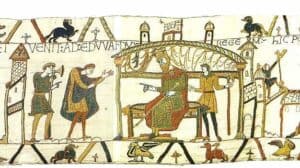
Bayeux Tapestry depicting Edward the Confessor meeting Harold Godwinson - Despite the banishment of the Godwins in 1051, Edward had largely relied on Harold in the mid-1050s. Despite this, a succession crisis occurred which resulted to the Norman conquest of England.
- The Godwinsons included Sweyn, Harold, Tostig, Gyrth, Leofwine, Wolfnuth, and Edith.
Claimants to the English throne
- Since the accounts of William Malmesbury in the 12th century, many historians believed that Edward had intentions of producing an heir. However, some argued that he had hoped to have an heir by Edith. In the absence of a biological heir, Edward’s death caused a succession crisis.
- Just a few months after his coronation, Harold was killed at the Battle of Hastings by William, Duke of Normandy. On Christmas day of 1066, William was crowned William I, the first Norman king of England.
Veneration
-
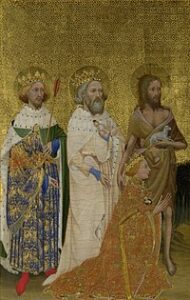
(from left to right) Edmund the Martyr, Edward the Confessor, and John the Baptist presenting Richard II to the Virgin Mary as depicted in a panel of the Wilton Diptych Along with English royal saints such as Eadburh of Winchester, Edgar the Peaceful, and Edward the Martyr, Edward the Confessor was venerated by the Catholic Church and the Church of England. However, unlike them, Edward was the first Anglo-Saxon king of England to be canonised.
- It was Osbert of Clare, the prior of Westminster Abbey who campaigned for Edward’s canonisation in the early 12th century. In the Vita Ædwardi Regis, Edward had been celibate even before his marriage to Edith which explained their childlessness.
- With the support of Henry II and the English hierarchy, Pope Alexander III canonised Edward the Confessor on 7 February 1161.
- Edward was called as “the Confessor” for having lived a saintly life but not a martyr.
- In 1350, Edward the Confessor, Edmund the Martyr, and Gregory the Great were considered as English national saints.
- Since 1269, the shrine of Edward the Confessor remained in Westminster Abbey. Under the Catholic Church and the Church of England, Saint Edward was the patron saint of difficult marriages.
- Edward the Confessor was regarded as the favourite saint of English kings, Henry III and Richard II.

